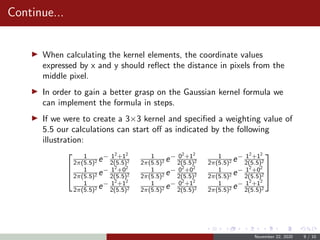Kernels in convolution
- 1. Kernels in Convolution By Revanth Kumar November 22, 2020 November 22, 2020 1 / 10
- 2. Overview Introduction Types of kernels Definition Convolution filters Gaussian Kernel Calculating Gaussian Convolution Kernels November 22, 2020 2 / 10
- 3. Introduction Convolutions are mathematical operations between two functions that create a third function. In image processing, it happens by going through each pixel to perform a calculation with the pixel and its neighbours. In Convolutional neural network, the kernel is nothing but a filter that is used to extract the features from the images. A convolution lets you do many things, like calculate derivatives, detect edges, apply blurs, etc. A very wide variety of things. And all of this is done with a ”convolution kernel”. The kernels will define the size of the convolution, the weights applied to it, and an anchor point usually positioned at the center. November 22, 2020 3 / 10
- 4. Types of kernels Gaussian K(u) = 1 √ 2π e− 1 2 u2 Logistic K(u) = 1 eu + 2 + e−u Sigmoid function K(u) = 2 π 1 eu + e−u November 22, 2020 4 / 10
- 5. Definition A kernel is a non-negative real-valued integrable function K. For most applications, it is desirable to define the function to satisfy two additional requirements: 1. Normalization: ∞ −∞ K(u)du = 1 2. Symmetry: K(−u) = K(u) for all values of u . November 22, 2020 5 / 10
- 6. Convolution filters An image can be seen as a matrix I, where I(x, y) is the brightness of the pixel located at coordinates (x, y). A convolution product is computed between the matrix I and a kernel matrix K which represents the type of filter. K can be of size 3 × 3 or 5 × 5. The result of this product will be the new brightness of the pixel (x, y). I∗K = I(1, 1) I(1, 2) ... I(1, n) . . . . . . I(m, 1) I(m, 2) ... I(m, n) ∗ K(1, 1) K(1, 2) K(1.3) K(2, 1) K(2, 2) K(2, 3) K(3, 1) K(3, 2) K(3, 3) Where I ∗ Kx ,y = 1 i=−1 1 j=−1 I(x + i, y + j) ∗ K(i, j) November 22, 2020 6 / 10
- 7. Gaussian Kernel In image processing filters are mainly used to suppress either the high frequencies in the image, i.e. smoothing the image, or the low frequencies, i.e. enhancing or detecting edges in the image. An image can be filtered either in the frequency or in the spatial domain. The corresponding process in the spatial domain is to convolve the input image f(i,j) with the filter function h(i,j). This can be written as: g(i, j) = h(i, j) f (i, j) The discrete convolution can be defined as a ‘shift and multiply’ operation, where we shift the kernel over the image and multiply its value with the corresponding pixel values of the image. For a square kernel with size M× M, we can calculate the output image with the following formula: November 22, 2020 7 / 10
- 8. Calculating Gaussian Convolution Kernels The Gaussian filter uses the Gaussian function in the kernel of the filter: G(x, y) = 1 2πσ2 e− x2 + y2 2σ2 This filter is a weighted filter which gives more importance to the central pixels. The parameter σ controls the weight given to the center. where, G(x,y) =The variables referenced as x and y relate to pixel coordinates within an image. e = represents the value of Euler’s number has been defined as a mathematical constant equating to 2.718. σ = represents a threshold or factor value, as specified by the user. November 22, 2020 8 / 10
- 9. Continue... When calculating the kernel elements, the coordinate values expressed by x and y should reflect the distance in pixels from the middle pixel. In order to gain a better grasp on the Gaussian kernel formula we can implement the formula in steps. If we were to create a 3×3 kernel and specified a weighting value of 5.5 our calculations can start off as indicated by the following illustration: 1 2π(5.5)2 e− 12 +12 2(5.5)2 1 2π(5.5)2 e− 02 +12 2(5.5)2 1 2π(5.5)2 e− 12 +12 2(5.5)2 1 2π(5.5)2 e− 12 +02 2(5.5)2 1 2π(5.5)2 e− 02 +02 2(5.5)2 1 2π(5.5)2 e− 12 +02 2(5.5)2 1 2π(5.5)2 e− 12 +12 2(5.5)2 1 2π(5.5)2 e− 02 +12 2(5.5)2 1 2π(5.5)2 e− 12 +12 2(5.5)2 November 22, 2020 9 / 10
- 10. Continue... The calculated values of each kernel element: 0.00509 0.00517 0.0521 0.00517 0.00526 0.00517 0.00509 0.00517 0.00509 An important requirement to take note of at this point being that the sum total of all the elements contained as part of a kernel/matrix must equate to one. At this point the sum total of the kernel equates to .046322. The kernel values should be updated by multiplying each element by one divided by the current kernel sum. k = 0.1098 0.1117 0.1098 0.1117 0.1135 0.1117 0.1098 0.1117 0.1098 Now, successfully calculated a 3×3 Gaussian Blur kernel matrix which implements a weight value of 5.5. November 22, 2020 10 / 10









